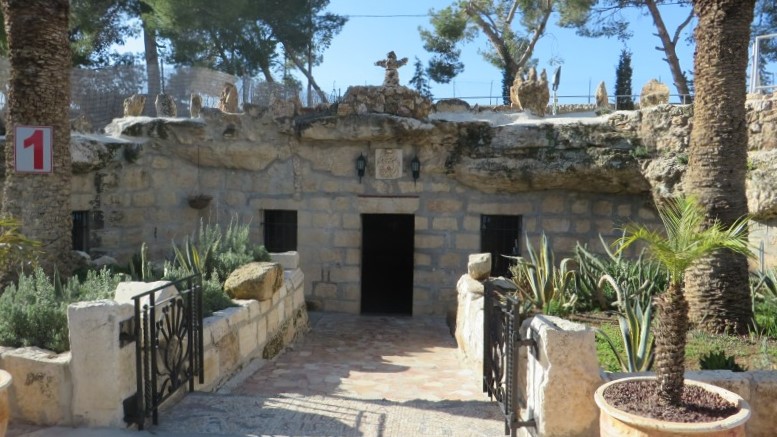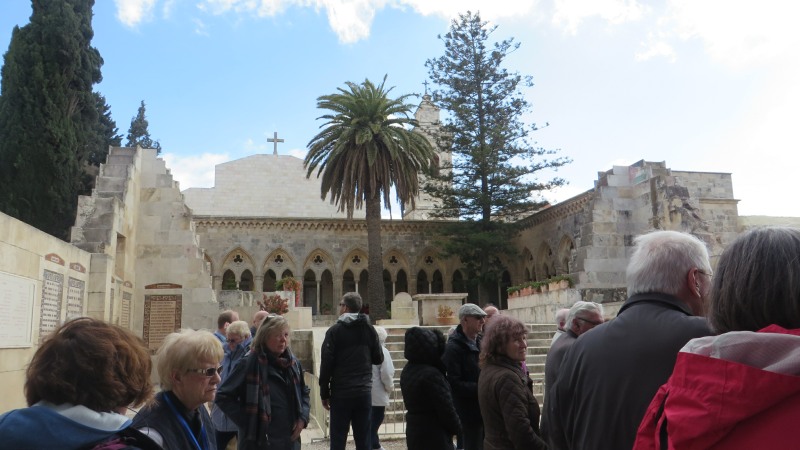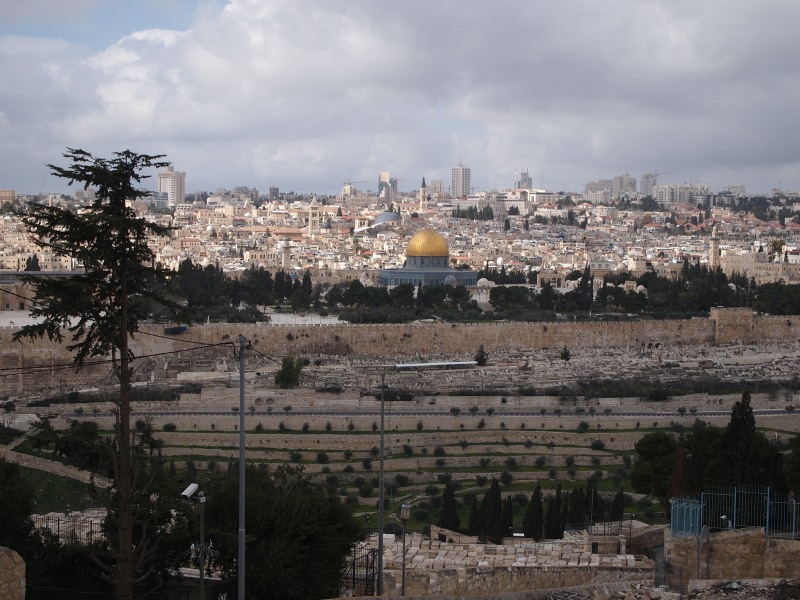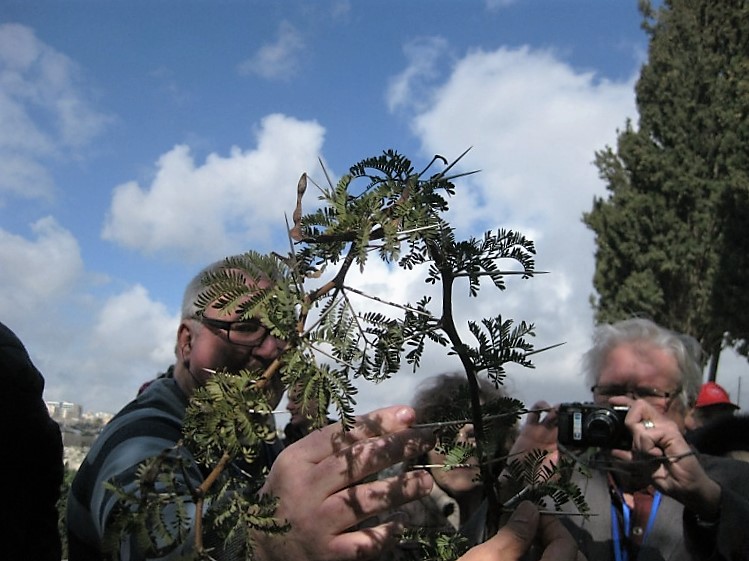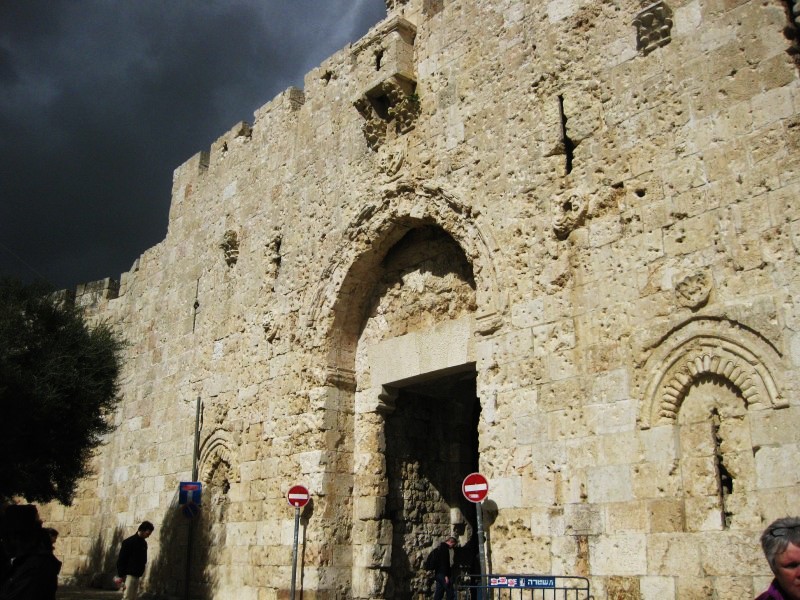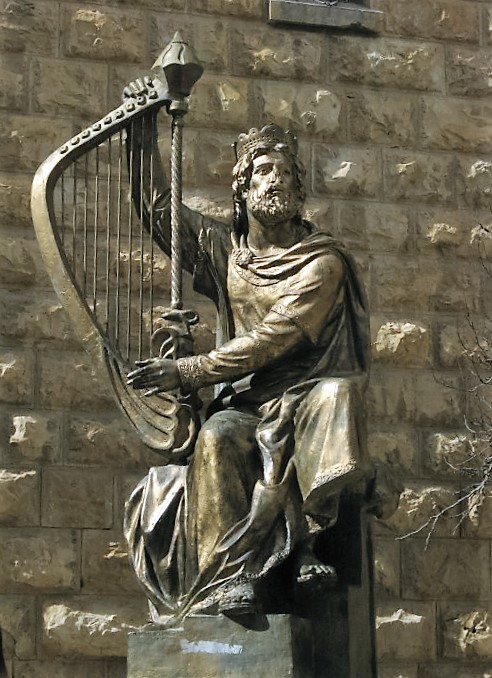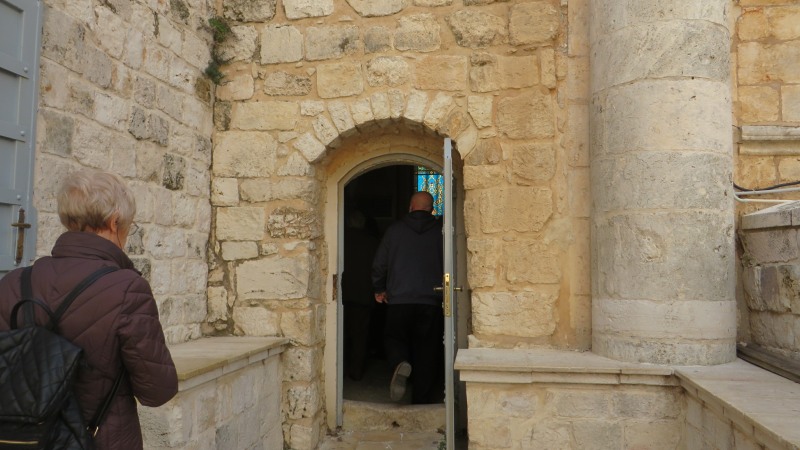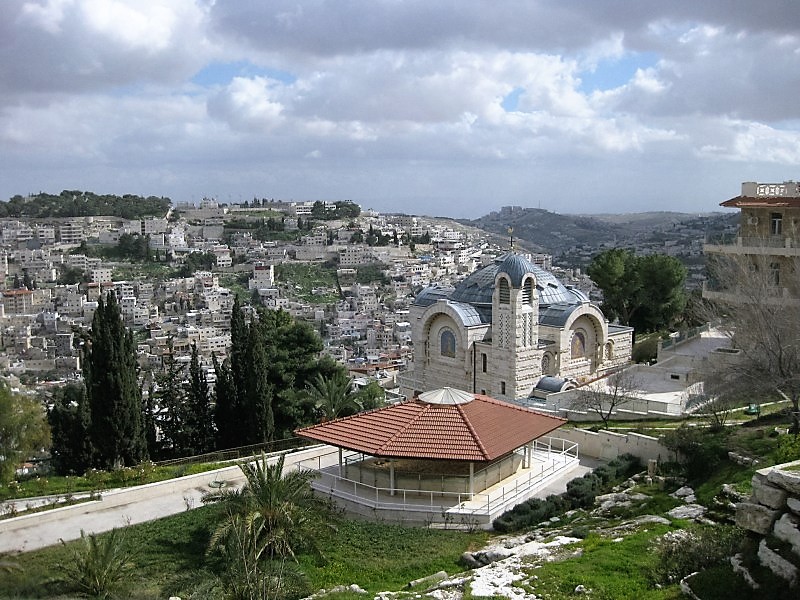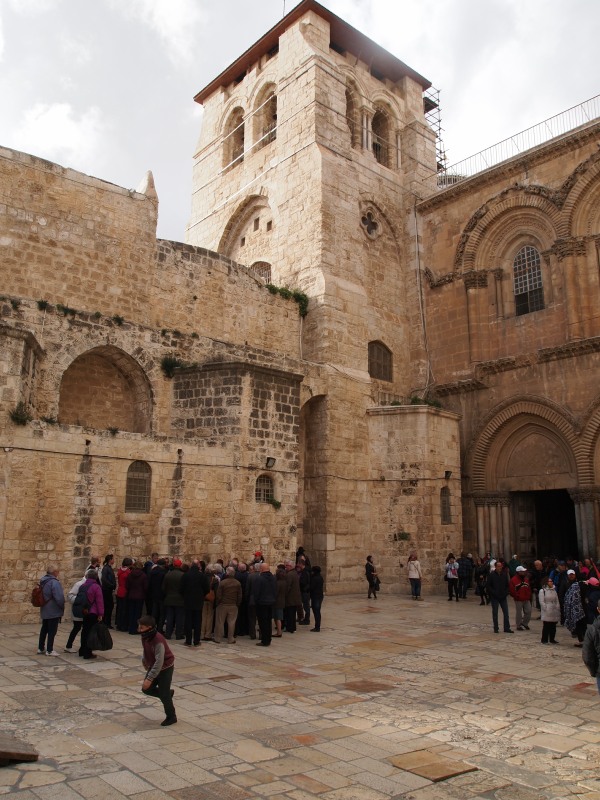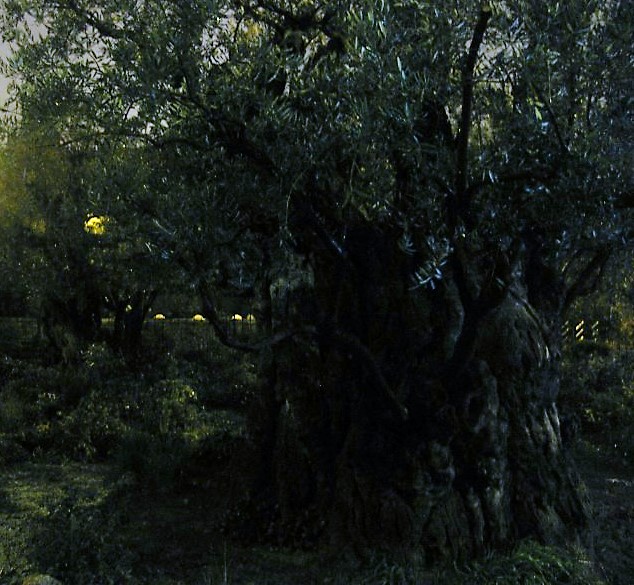It is with mixed feelings that I leave the hotel this morning. Sad to be saying my farewells to these generous, gentle people who welcomed us so warmly into their lives, happy to do anything for you, always with a big smile on their face, in spite of the difficulties they face in their own challenged lives. But, at the same time, looking forward to finally going to Jerusalem, a city that has been a presence in my life ever since I was a child and first heard the Gospel stories.
The first stop on our journey is at Shepherd's Fields which lies about 2 km to the East of Bethlehem. Traditionally, shepherd's met here during the winter months to care for their flocks as a community (probably similar to the shepherd's meets we have in our own country where they meet to exchange sheep, stories and tips). Here, it is easy to imagine the wonder such unsophisticated folk felt when their peace was invaded by the song of angels; their excitement as they hurried on their journey to Bethlehem; the awe with which they worshipped the new born king.
The carefully maintained grounds are surrounded by a wall and lie on a hillside overlooking a valley. We pass between cultivated beds over limestone slabs and stoop to enter a low cave. Within, the rock hewn roof challenges some of the taller members of the group. Around the walls archaeological artefacts are randomly placed in alcoves - a broken pot, a carved stone - all evidence that this has been a place of importance to Christians for generations. Low benches surround the walls and fill the centre of the floor. A stone altar stands at one end of the cave. This is just one of a small number of chapels available for group worship.
Our mass takes the theme of the Shepherd’s story and we join in joyfully with the ‘Gloria’. At the Prayers of the Faithful a statue of the infant Jesus is passed round for each of us to say our own private prayer. I'm not sure how I feel about this as I watch people take the statue into their hands. Some seem quite happy to hold the statue and say a prayer, some are moved by their experience, others are clearly not comfortable with the idea and quickly pass it on. I wonder.......it is my turn. I accept the statue from my neighbour and look at it, awkwardly praying 'Thank you Jesus for being born for us...' Suddenly I think of my grandchildren, their infectious enthusiasm for life, the love and joy they bring into my world, the wonder they find in even the smallest things in their lives. I am filled with gratitude for the gift of these wonderful children. I think to myself that Jesus was once an infant like them, with boundless energy and unconditional love spilling out into the lives of all they touch. I thank the Lord for the gift of their presence in my life............and pass the infant Jesus on to the next person with a big grin on my face.
After mass we have a short time to explore the grounds. There is further evidence the place has been used for many centuries - an old olive press, stone buildings, more pottery. I spot a tree on the edge of the plateau, just bursting into blossom. I pick my way over towards it and stop. The beauty of the tree is in stark contrast to the sprawling settlement being dug into the hillside on the opposite side of the valley. Row upon row of multi-storey flats have been constructed. In front and to the sides of them the concrete slabs of a wall are under construction and in front of that a wire fence demarcates the land claimed. To one side there is evidence of digging by heavy machinery creating terraces out of the land for ease of construction. At the foot of the hill lie several buildings which look as though they have been part of a village, now empty and in ruins. With saddened heart I turn and make my way back to the coach.
Our journey to Jerusalem is via a quieter route than our journey in to Bethlehem. The road looks newer. To the side, the walls of settlements sprawl along the line of the road. At the checkpoint itself, the coach stops and a soldier, armed with a heavy weapon of some sort, climbs on board briefly to check us out whilst Usama is questioned. We look unthreatening as she soon disembarks and waves us through. To the side of the road any remaining countryside is gradually swallowed up into the urban sprawl that is the outskirts of Jerusalem. We make our way round the outer edge of the old city and then climb up a hill at the top of which we get out.
Walking through a gateway we find ourselves in a paved courtyard area. Surrounding us are walls upon which tiled plaques have the 'Our Father' written upon them, each in a different language. We have arrived at the Church of the Pater Noster. The building is incomplete, although reconstruction of the site started in the early 1900s. Earlier churches had been built over the site of a cave traditionally identified as the place where Jesus taught his disciples the 'Our Father'. Descending a short flight of steps we find ourselves in the antechamber to the cave itself, which has partially collapsed. We sing the 'Echo Our Father'. It is strange and rather moving to think that the disciples would have been taught to pray in the same 'repeat after me' fashion......... Emerging from the cave we briefly explore the immediate area and once again the universality of Christianity is brought home to me as I take in the number of 'Our Fathers' displayed in so many different languages.
A short coach drive later and the more active members of the party disembark. Before us lie the white buildings and gleaming domes of Jerusalem. To our left is a vast cemetery filled with tombs, a favoured location for Jewish believers to be buried, as they believe that on the Last Day the people who are buried in this place will be the first to rise from the dead. To our right is the Mount of Olives. Below us lies the Kedron Valley. At our feet is the route that Jesus would have taken on Palm Sunday as he made his entry into Jerusalem on the back of a donkey, 'Hosannas!' filling the air.
Descending a flight of steps we walk part way down the steep hillside and turn into the gateway which leads into the gardens of the Mount of Olives. We are shown an example of a tomb typical to one which would have been used to bury Jesus after his crucifixion. We peer through a small opening, down a short flight of steps leading into an underground cave cut into the limestone. Much smaller than I have always imagined, but it makes more sense when you consider the numbers of people who might be buried this way. It's also easy to see how a stone would be used to cover the entrance to the cave.
In front of us we can see the golden domes of the Church of Mary Magdalene, a Russian Orthodox church built on the Mount of Olives. Across the valley the Golden Gate is pointed out to us in the walls of Jerusalem. The gate is sealed and will remain so until the Messiah comes to redeem the Jewish people..........
We move on and a man greets us. He indicates some trees growing close by, pointing out the thorns protecting them. Twigs from these would have been used to create the crown of thorns. He goes away and then returns with just such a twig. Fr Paul (the Elder) holds it gingerly. The thorns are longer than any I have seen before, being at least 7cms long and looking rather like needles..... I try to imagine what it must have been like to wear a crown made of such thorns......... and fail miserably.
Behind us a tear shaped church stands on a terrace. This is Dominus Flevit Church. Built by Antonio Barluzzi on the site of a 5th century Byzantine church which in turn was built over much earlier remains, it recalls the passage in St Luke's Gospel in which Jesus weeps over the fate which is to overcome Jerusalem. Inside, the church is quite simple in style, but with a stunning arched window with a host and chalice at its centre. Through this I can see the spiritual centres of Jerusalem - the Dome of the Rock overlying the location of the temple and the Church of the Holy Sepulchre.
The small church is quite crowded, so we exit quickly and walk back through the grounds to resume our walk down the Palm Sunday route. At the bottom we are met by the coach and climb aboard for a brief journey to our next stop on the outskirts of the old city.
Walking up a pathway we come to the Zion gate set in to the city walls. It is badly peppered by bullet holes, a legacy of the 1948 War of Independence and the 6 Day War of 1967. Moving on we come to the Church of Dormition, the place identified in Christian tradition as being where Mary died or fell asleep. Again this is a church built on Byzantine ruins dating back centuries. There is an upper church with a beautiful mosaic of Our Lady and the Infant Jesus above the main altar. Around the side of the church there are other smaller altars. The floor has various mosaics patterned into it. Winding down a spiral staircase we come to the lower church. In the centre is a rotunda in which lies a full sized statue depicting Mary as she was at the end of her life on earth. Again there are various chapels around the walls of the place. I must confess that I found this particular church dark, gloomy and uninspiring, but that's only my experience and others seemed to find the visit interesting.
Church of the Dormition Gallery
Emerging back into the bright sunlight we work our way down a narrow street, through crowds of people, into an open area with a beautiful statue of King David playing his harp.
Ascending some stairs we enter the Upper Room. It is packed full of people. I lean against a rail and try to take in what I am looking at. The room is quite large and looks rather like a medieval banqueting hall. The ceiling is high with columns and tall arches supporting it. One window nearby is beautifully coloured with stained glass, I recognise Arabic lettering within the patterning. More lettering appears on a plaque on the wall. There is a marble niche in one wall and a tree like sculpture in the opposite wall. Stairs lead up from one corner and down from a different corner, which has a dome like structure over the stairway. Usama gathers our group around him and explains what we are seeing.
This is a place of great importance to Judaism, Islam and Christianity. The Cenacle dates back to the time of the Crusaders and was built over an earlier construction of a church-synagogue dating back to the 1st Century. This is explained in the plaque on the wall. After the Turks captured Jerusalem in the 16th century, the building was converted into a mosque and contains a mihrab (the niche), which indicates the direction of Mecca. The room is located above a shrine venerated as the Tomb of King David, formerly accessed by the descending steps. The steps upward lead to a smaller room, which some believe to be the place where the Apostles were gathered on Pentecost Day. The bronze sculpture is of an olive tree, donated by the Catholic Association that had the entire building restored at its expense.
It is not known if this is truly the site of the Last Supper, but there is a strong possibility, based on the archaeology, that it is. In the corner with the dome there is a column, unlike any of the other pillars in the room. The capital of the column depicts young pelicans feeding on the blood that their mother has drawn from her breast, a symbol of the Eucharistic sacrifice of Christ giving himself for us. This earlier pillar had been found beneath the current building during renovations and was incorporated into the rebuilding of the room. I touch the pillar, glad that something still remains of that earlier building.
Sadly, it is not permitted to celebrate mass in this place of such significance to Christians, although Pope John Paul II and Pope Francis had been allowed to on their visits to Jerusalem. I try to imagine the scene of the Last Supper in a place such as this and pray silently to the Lord.
We make our way out of the building and then down the steep hillside to the Church of St Peter in Gallicantu. The church is built over what is thought to be the site of Caiaphas's house, to which Jesus was taken during his trial. It was here that St Peter denied him three times. Gallicantu is the Latin for cock-crow and every now and then a black cockerel can be seen set into a wall. The church is a rather beautiful building with a golden cockerel standing on a black cross rising from its dome.
We walk down several steps to a courtyard area which has a statue depicting the denial of Jesus. On the wall there is a mosaic showing Jesus being mocked by various people. Behind a walled and railed area there is a stepped street which leads from Mount Zion to the Kedron Valley. It is highly likely that Jesus would have used this route to go to Gethsemane after the Last Supper.
Usama asks us to consider the context of Peter's betrayal - a simple fisherman taking his courage in his hands to follow someone who has inspired him to change his life. Peter must have been overwhelmed and terrified by his experiences in Jerusalem and the capture of Jesus. You can understand his initial reaction to deny any knowledge of him when asked if he knows Jesus.
We enter the middle section of the church. Inside it is bright and airy, with modern stained glass windows letting in the light. The chapel has several icons on its walls showing Peter's denial, his repentance and his reconciliation with Jesus on the shore of Galilee after the Resurrection (the location of the Primacy of Peter we visited on our second day!). There is a well like opening in the floor of the church. On the side can be seen Byzantine carvings of crosses. Usama had explained to us in the courtyard that many scholars believe that Jesus was kept imprisoned at the house of Caiaphas for a time, as there are several hours unaccounted for during the story of the Passion and Death of Jesus. It is believed that he would have been lowered through this hole in the floor to the basement, his place of imprisonment.
Leaving the church we descend more stairs to some caves cut into the rock dating back to the time of Jesus. At that time they may have been cellars or cisterns - or a jail. The guardroom has wall fixtures to attach prisoner's chains to prior to flogging or other torture. Further steps lead to the Sacred Pit, where it is believed Jesus was imprisoned on the night before his crucifixion. Now, it is lit with carefully positioned lights, but then, it was a dark hole in the ground. Through a second aperture, jeering guards in the guardroom above could have overlooked their prisoner. Who can really imagine the pain Jesus endured or the psychological impact of such an incarceration? We listen to a reading and then pray our own silent prayers in this place where Our Lord suffered at the hands of those who failed to see the truth of his teachings.
St Peter in Gallicantu Gallery
We emerge into sunlight and have a short time to explore the grounds, view the remains of a Byzantine Village or grab a quick drink before boarding the coach once more to return to Jaffa Gate and the Old City of Jerusalem. Here we quickly make our way along narrow streets, passing shops and market stores until we emerge in the courtyard outside the Church of the Holy Sepulchre. Externally, the church looks quite small and seems to be incorporated into other buildings to either side. There seems to be a fair bit of renovation going on. There is a constant flow of people in and out of the building.
Usama gathers us together and tells us about the history of the church. The original church was built by the Emperor Constantine, urged by his mother, St Helena. The site had a history of being a place of execution and the remains of 1st century tombs, gardens and fragments of wooden planks were to be found there. Christians had seen this as the place of Jesus's passion, death and resurrection long before Helena declared it as such. Over the centuries the church was destroyed or rebuilt depending on whoever had control of the city at the time and also as a result of an earthquake.
The church is controlled by several different Christian denominations, Catholics, Armenian, Greek Orthodox, Syrian Orthodox, Coptic and Ethiopian. Each has a jealously guarded responsibility for a different section. However, it is Muslim families who hold the key to the main door, and have done since 1187. And it is they who manage the church and mediate between the different denominations when there is conflict. Disagreements between the different denominations have resulted in all kinds of difficulties, especially when it comes to restoring the church, as one group or other continually challenges the others right to care for any particular area. This conflict has even extended to the positioning of a ladder on the roof by one group, whilst another challenges their right to do so.
As it is so busy and we have not yet checked into our hotel for the next couple of nights, plus we need to get dinner promptly this evening, we decide to postpone our visit to the interior of the church until tomorrow, when it will become the last stop on our route. We are given some free time to find some refreshments or do some shopping before we need to meet up again.
I walk over to a seat-like wall that lines one edge of the courtyard, sit down to eat some fruit and watch the world go by. People of many different races are converging on this sacred site, taking the time to visit, ponder and, perhaps, pray. They react in different ways to their visit, some emerge thoughtfully, others are eager to share their thoughts with their companions; some seem to see their visit as just another place to visit on their tour, indifferent to what happened in this location 2000 years ago.
The wind is getting chilly so I decide to go and explore further and immediately bump into Ann, who takes me to the cafe of one of her friends, where we get a chip pitta - delicious in the chill air. Walking back through the alleyways we meet other people she has befriended over the years, each delighted to see her and keen to invite her into their store, but Ann is on a mission to a particular shop. On arrival we are warmly greeted and offered a drink. Ann then shows her negotiating skills as she purchases skull caps, prayer shawls, prayer beads and a variety of other items.
Sometime later we emerge and make our way back to the Church of the Holy Sepulchre to meet up with the rest of the group and guide them back to the Jaffa Gate and the coach. During the journey to the hotel we are regaled with stories, all seeming to begin with 'This is a true story.......' - a stand-up comedian in the making.
Our reception at the Olive Tree Hotel is in stark contrast to that which we received at our hotel in Bethlehem. Admittedly it is a much bigger hotel and another coach party has arrived at the same time as us, but there is almost an air of indifference to the arrival of both parties. Organised chaos reigns as people gingerly negotiate their way round bags and each other in the reception area. I escape to my room as quickly as possible and prepare for dinner.
Later, we board the coach for the Garden of Gethsemane, which lies at the foot of the Mount of Olives. On arrival, the rain is torrential, the gutters overflowing and the road awash with water. We stride over puddles or make a diversion to a dry patch to cross the road. Traffic toots impatiently at our efforts. Walking up a steep slope, we pass through a gateway and enter the grounds of the church.
The noise of the traffic fades into the background as we walk along darkened pathways, passing ancient olive trees, sensed more than seen in the darkness. Under one, in white pebbles, the word 'Peace' is spelled out.
We enter the church. A high multi-domed roof supported by marble pillars. In front of us is the main altar with a large mosaic behind illustrating Jesus, alone, at prayer in this garden. In front of the altar lies a flat slab of rock. Tradition holds that this is the rock upon which Jesus prayed. The rock is surrounded by benches where a group of young Mexican girls, on a visit from their school in Switzerland sit. We later learn that they are novices, or perhaps postulants, in an order of nuns. We seat ourselves in more benches to right and left of the altar and settle down to share this Holy Hour of prayer with these young people.
Our prayer is in a mixture of Spanish and English, interspersed with hymns from both groups, beautifully sung by the young people, a bit gravelly when sung by our older group. There is also plenty of quiet time, during which I ponder the words of the Gospel - how would I have acted on that evening? Would I have fallen asleep too...? Probably - and then been filled with remorse when I'd realised what had happened. How did Jesus feel at this time of abandonment, knowing what was to come? How can I even begin to imagine the encroaching terror he must have felt?
I regard the students before me, sitting in stillness, deep in thought. Some are filling in their prayer journals, inspired by the moment. Others are in tears, touched by the reality of this place. Their reaction moves me almost to tears and I wonder how and why my own faith has changed from what it was when I was a younger. I pray that I may open myself more to the Word of God in my life, to be more accepting of his will for me.
The hour passes quickly and it is time for the girls to leave the church. Many of us exchange words with them, thanking them for sharing this special time with us. We then approach the limestone slab to touch it; pray a short prayer; ponder on that night of torment. Then, regretfully, step back out into the wet darkness of the night to return to the hotel.
Gethsemane and Church of All Nations Gallery
Day 3 - For Nothing is Impossible to God
Day 4 - The Prophet of the Most High
The thoughts and impressions stated are those of the writer only and may not reflect the feelings and opinions of others in the group.

